What woodpeckers can you see in Germany? There are 8 different species of woodpecker that you might encounter in Germany. Read this article to see pictures, hear their sound and get great information about where and when you can spot all woodpeckers in Germany.
Germany: a land steeped in history, culture, and an enduring love affair with nature. As you wander through its diverse landscapes, from the dense Black Forest to the serene lakes of Bavaria, you’ll hear a rhythmic symphony – the drumming and calls of woodpeckers echoing through the trees. These avian wonders, with their distinct patterns and behaviors, serve as nature’s percussionists, each species adding its unique beat to the soundtrack of the German wilderness. In this article, we’ll venture deep into the heart of Germany’s forests, meandering alongside these incredible birds, unraveling their stories, and experiencing the timeless dance of life they represent. So, adjust your binoculars and lend an ear, as we embark on this melodic journey through the vibrant world of Germany’s woodpeckers.
Let’s jump into the article.
1. Eurasian Three-toed Woodpecker
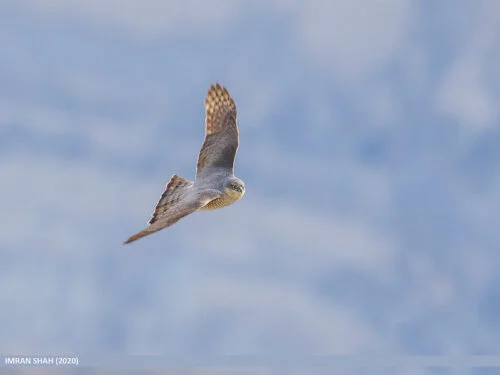
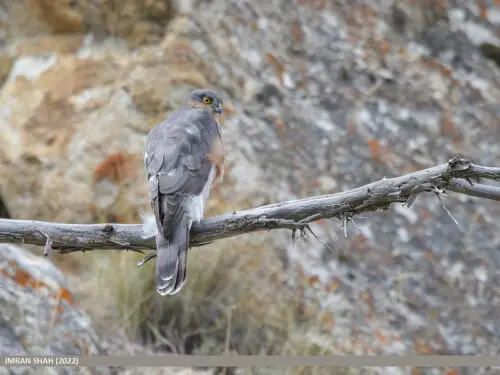
In the secluded corners of Germany’s vast forests, where myths come alive and nature sings its oldest songs, the Eurasian Three-toed Woodpecker makes its discreet presence felt. Unlike its more widespread cousins, this woodpecker is an emblem of the wilderness, often preferring the serenity of ancient coniferous woods.
Dressed in a muted palette of blacks, whites, and soft grays, the Eurasian Three-toed Woodpecker is elegance personified. The males sport a subtle yellow cap, which is absent in the females, making them easily distinguishable.
Venturing mainly in the dense spruce forests of Bavaria and the Harz Mountains, this bird is perfectly adapted to its environment. Its preference for older trees, often affected by fungal infections or pest infestations, aligns with its diet of wood-boring beetles and other insects.
The soft drumming of the Eurasian Three-toed Woodpecker is a unique forest symphony, more subdued compared to its relatives but no less enchanting. This bird’s life revolves around the age-old trees it calls home — from foraging for food on their trunks to crafting intricate nests within their heartwood.
For those seeking the true essence of Germany’s wild woods, an encounter with the Eurasian Three-toed Woodpecker is a rewarding experience. Each drumming note, every fleeting glimpse, adds a new chapter to one’s understanding of the rich biodiversity that thrives in the German heartland.
2. Middle Spotted Woodpecker
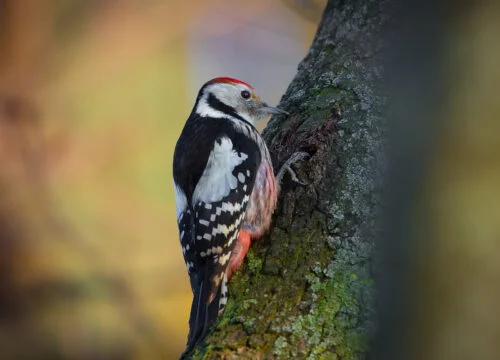
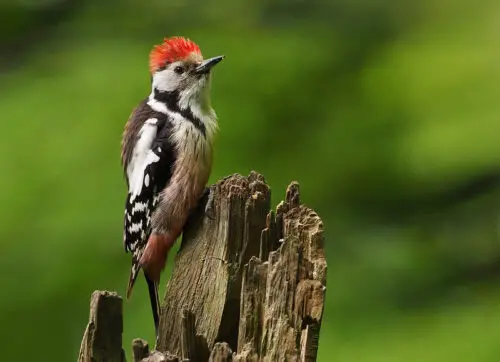
Emerging as a vibrant page from Germany’s verdant storybook, the Middle Spotted Woodpecker paints the country’s woodlands with a dash of playfulness and color. This relatively small woodpecker offers a delightful mix of beauty and intrigue, making it a cherished sight for birdwatchers and nature enthusiasts alike.
Cloaked in a dappled coat of white and black, with a reddish belly that contrasts elegantly against its feathers, the Middle Spotted Woodpecker is truly a sight to behold. But perhaps its most distinguishing feature is the eye-catching crimson cap that sits atop its head — a crown that seems to capture the very essence of German woodlands.
This avian wonder prefers the deciduous forests that are scattered generously across Germany. Broad-leaved woodlands, particularly those dominated by oak, beech, and hornbeam, are where this woodpecker truly feels at home. Regions like the Rhine Valley, the forests of Baden-Württemberg, and the gentle landscapes of Lower Saxony are among its favorite haunts.
With a diet primarily consisting of insects, larvae, and occasionally fruits and nuts, the Middle Spotted Woodpecker is an adept forager. Using its sharp beak, it skillfully navigates the mid and upper levels of trees, extracting hidden delicacies from the bark and branches.
The rhythmic drumming of this bird, though softer than some of its larger counterparts, is a familiar sound in German forests, especially during the early stages of spring when the mating season begins. It’s during these times that the intricate patterns of their courtship dances and the soft chattering calls become most evident.
Witnessing the Middle Spotted Woodpecker in its natural habitat is like immersing oneself in a timeless German fable. Each beat, each flutter, and each song is a testament to the nation’s commitment to preserving its natural heritage, and a reminder of the wonders that lie hidden in its sprawling forests.
3. White-backed Woodpecker
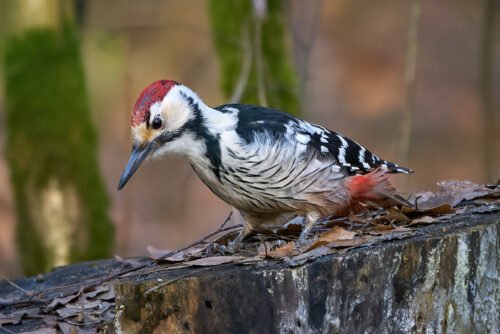
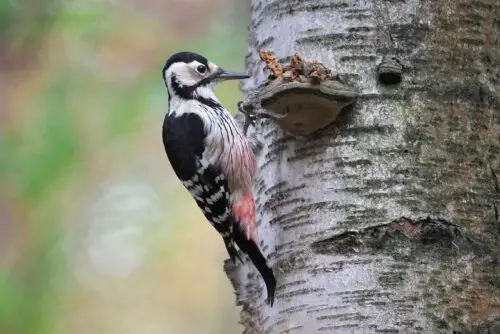
In the tapestry of German woodlands, the White-backed Woodpecker stands as a rare and delicate thread, weaving tales of elusive beauty and old-growth mysteries. Often regarded as one of Europe’s most secretive woodpeckers, its presence in Germany is a symbol of wilderness, an echo of forests untouched by the tides of modernity.
Donning a sleek ensemble of black and white, this bird gets its name from the strikingly white lower back and rump, which contrasts vividly against its dark wings. The males, not to be outdone in the fashion department, adorn themselves with a bold crimson cap, while the females sport a more understated look, entirely devoid of the red hue.
Germany’s ancient woodlands, particularly those housing mature deciduous trees interspersed with dead or dying trunks, are the preferred realm of the White-backed Woodpecker. Here, in the deep woods of Bavaria and the fringes of the Black Forest, this bird finds its sanctuary. The decayed trees, especially beech and oak, provide a rich hunting ground, teeming with insects, larvae, and other delectable treats.
Not just a mere forager, the White-backed Woodpecker is also an artisan of sorts, crafting intricate nesting cavities with impeccable precision. Its drumming, a rhythmic series of beats, serves as both a territorial declaration and a call to potential mates during the breeding season.
While sightings of the White-backed Woodpecker can be a challenge even for seasoned birdwatchers, the sheer thrill of spotting one in the wild is an experience that resonates deeply. It’s a brush with the primal, a fleeting moment that ties one to the age-old forests of Germany, and an affirmation of nature’s resilience and wonder.
For those who tread lightly and listen intently, the White-backed Woodpecker’s song becomes a hymn of the German wilderness, a melodious reminder of the fragile beauty that graces our world.
4. Great Spotted Woodpecker
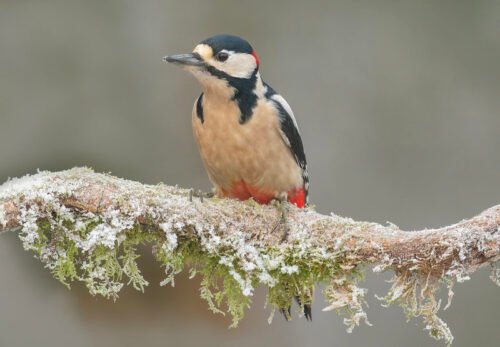
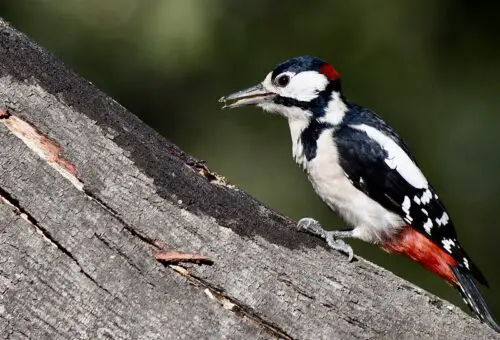
As one meanders through Germany’s vast woodlands, from the rolling hills of Bavaria to the mystical depths of the Black Forest, the drumbeat of the Great Spotted Woodpecker serves as a rhythmic guide. Prominent, charismatic, and brimming with life, this bird embodies the heartbeat of German forests, captivating the hearts of both seasoned ornithologists and casual nature lovers.
Garbed in a fetching mix of black, white, and crimson, the Great Spotted Woodpecker is undeniably stylish. Males sport a distinguished red patch on the nape, while the young are adorned with a crimson crown, which they shed as they mature. Their wings and back, patterned in contrasting black and white, make them easily identifiable as they flit from tree to tree.
Throughout Germany, this woodpecker has made its presence known. From dense forests to suburban gardens, and even city parks, the adaptability of the Great Spotted Woodpecker is truly remarkable. Such ubiquity is a testament to its diverse diet: insects hidden in the bark, seeds, nuts, and on rare occasions, even the eggs of other birds.
Possessing both grace and power, this bird can chisel into tree trunks with remarkable precision, crafting nesting holes or foraging for food. Its drumming, louder and more assertive than many of its peers, often reverberates through the woods, signaling territory or beckoning a mate.
In Germany, the Great Spotted Woodpecker isn’t just another bird; it’s a symbol. Representing the pulse of the land, its vitality, and the intertwined relationship between creatures and their environment. Encountering this bird, hearing its call, and witnessing its aerial antics is to experience a piece of Germany’s natural essence — a dance of colors, sounds, and life in the very heart of Europe.
5. Lesser Spotted Woodpecker
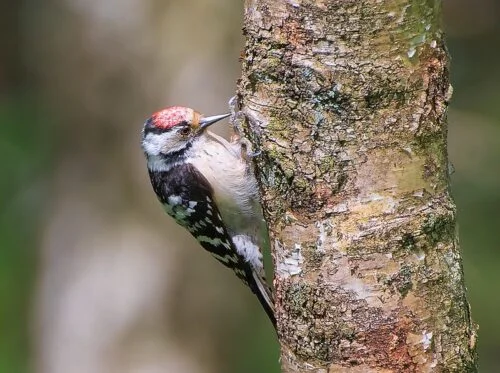
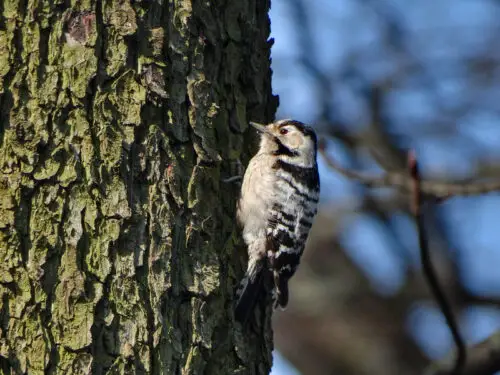
In the orchestral crescendo of Germany’s wilderness, the Lesser Spotted Woodpecker plays a gentle yet poignant melody. Diminutive in size but grand in spirit, this bird, with its soft drumming and evocative calls, adds layers of depth to the country’s rich avian tapestry.
Easily distinguished from its larger counterparts, the Lesser Spotted Woodpecker is a compact bundle of grace. Its plumage – a harmonious blend of whites, blacks, and subtle reds – is both understated and captivating. The males proudly wear a crimson cap, setting them apart from the more monochrome females. Despite its smaller stature, this bird’s presence in the woodlands of Germany is felt profoundly, its soft drumming echoing like whispered tales of old.
The mosaic of mixed forests, especially those of alder, birch, and willow, forms the ideal habitat for the Lesser Spotted Woodpecker in Germany. Regions like Brandenburg, Thuringia, and Saxony often play host to this tiny drummer, where it flits through the canopy in search of its next meal.
An agile forager, its diet comprises a variety of insects and their larvae, adeptly gleaned from twigs and bark. Their nests, often excavated in the softer woods of decaying trees, become cozy alcoves where they rear their young.
Yet, the Lesser Spotted Woodpecker is more than just a feathered resident of Germany’s forests. It stands as a gentle reminder of the delicate balance of nature, the intricate relationships that form the web of life, and the quiet wonders that often go unnoticed in our bustling world.
For those fortunate enough to witness this bird in its natural habitat, the experience is akin to uncovering a hidden gem in Germany’s crown of biodiversity. The Lesser Spotted Woodpecker, in all its modesty and charm, is a symbol of nature’s enduring poetry amidst the ever-changing landscapes of time.
6. Grey-headed Woodpecker
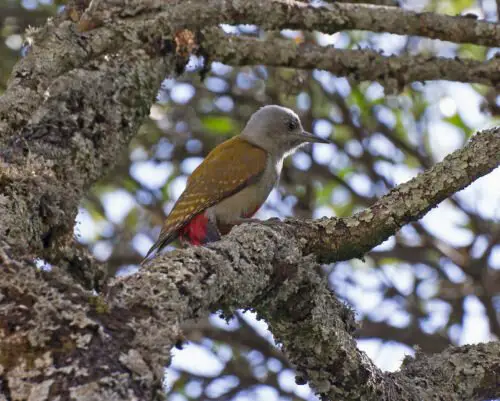
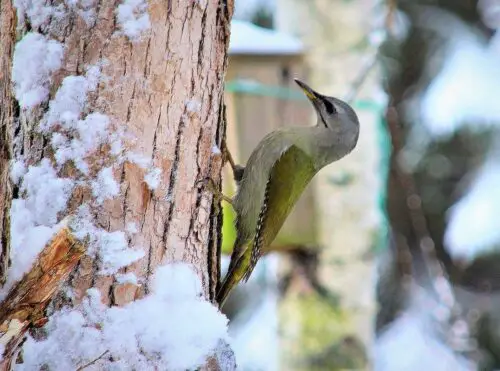
Amidst the lush tapestries of Germany’s verdant forests, the Gray-headed Woodpecker emerges as a graceful enigma, painting scenes of quiet elegance and timeless beauty. With its soft hues and serene demeanor, this bird represents the subtler shades of the German wilderness, a gentle whisper amidst nature’s grand symphony.
Cloaked in an understated attire, the Gray-headed Woodpecker is aptly named for its slate-gray head, which seamlessly transitions into an olive-green body. The soft green of its back and wings mingles with a pale underside, creating an appearance that’s both serene and alluring. While both genders possess this calming palette, the males are distinguishable by a small red patch on the top of their heads.
Germany’s mature deciduous forests, especially those speckled with old beech, oak, and pine trees, provide a haven for the Gray-headed Woodpecker. It is in these tranquil woods, particularly in areas like Bavaria and the Harz Mountains, where this bird finds both sustenance and solitude.
Adept at extracting insects and larvae from tree bark, the Gray-headed Woodpecker’s diet reflects its preference for older forests, where decaying trees are plentiful. Its soft yet rhythmic drumming often serves as a gentle backdrop to forest ambiances, accompanying the songs of other woodland birds.
While not as boisterous as some of its relatives, the Gray-headed Woodpecker possesses a quiet charisma. Its presence in Germany’s forests speaks of age-old tales, of seasons that have come and gone, and of the intricate dance of life that unfolds in nature’s embrace.
For those who venture into Germany’s wild corners with patience and reverence, a chance encounter with the Gray-headed Woodpecker becomes a memory etched in tranquility and wonder. This bird, in its gentle ways, is a testament to the myriad tales of beauty that the German woodlands hold in their silent embrace.
7. Eurasian Green Woodpecker
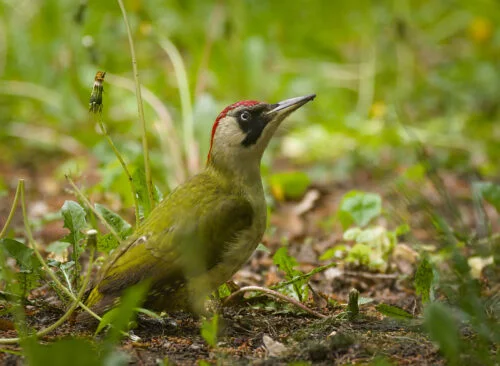
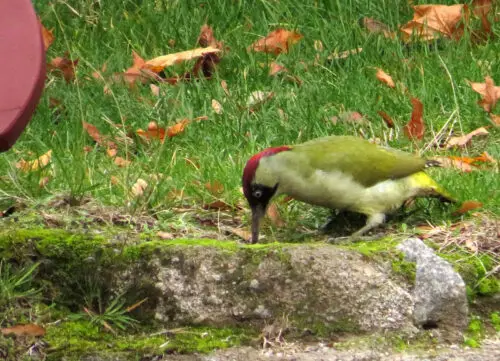
With a splash of vivid green against the muted browns and greens of Germany’s forests, the Eurasian Green Woodpecker emerges as a vibrant artist of the avian world. This charismatic bird, with its radiant plumage and infectious laughter-like calls, is a joyous herald of Germany’s rich biodiversity and a beloved figure in many a woodland tale.
Draped in a luminous green cloak, the Eurasian Green Woodpecker is hard to miss. Its radiant feathers, contrasted with a bold crimson crown and black moustachial stripe, create a striking visual spectacle. While both genders proudly flaunt their green attire, it’s the male that stands out with its red streak, a dash of color running from the eye to the base of the beak.
The mosaic of open woodlands, orchards, parks, and gardens across Germany offers a vast playground for this woodpecker. From the dense woods of Schleswig-Holstein to the sprawling parks of Berlin, its distinctive “yaffle” call is a familiar sound, often mistaken for hearty laughter echoing through the trees.
Unlike many woodpeckers who tap and drum on tree trunks, the Eurasian Green Woodpecker spends a significant amount of time on the ground, hunting its favorite prey: ants. With a tongue that can extend beyond its beak, this bird skillfully extracts ants and larvae from their nests, a sight that’s both fascinating and slightly comical.
Beyond its hunting prowess, the Eurasian Green Woodpecker is deeply embedded in German folklore. Its distinct calls, often linked to rain predictions, have given it a place in local legends as a weather prophet.
Experiencing the Eurasian Green Woodpecker in its German habitat is akin to witnessing a vivid brushstroke on a canvas of nature. Its presence is a celebration of life, color, and the myriad wonders that the German wilderness unfurls for those willing to pause and listen.
8. Black Woodpecker
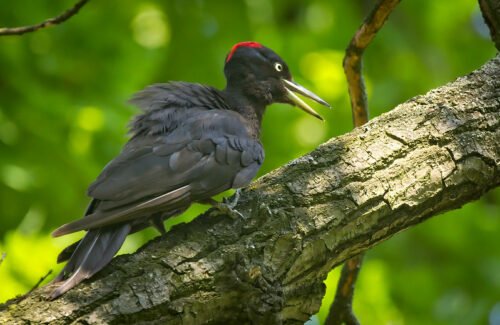
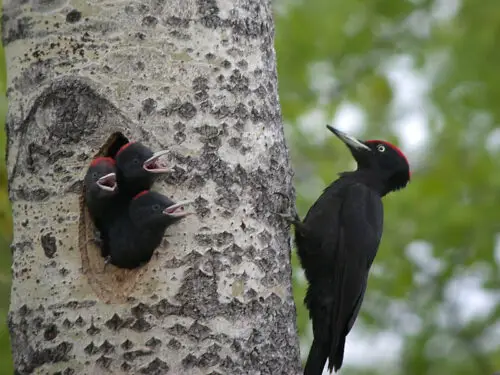
In the deep recesses of Germany’s dense, ancient forests, the silhouette of the Black Woodpecker is a sight that evokes awe and intrigue. As the largest woodpecker in Europe, this majestic bird, with its velvety black plumage and haunting calls, stands as a sentinel of the German woodlands, embodying their mystery and grandeur.
Clad entirely in a glossy black, the Black Woodpecker’s appearance is both simple and regal. Yet, it’s the stark contrast of its fiery red crown, especially pronounced in males, that gives it an air of royalty. This crimson crest, set against its raven-black feathers, paints a portrait of elegance and power.
The Black Woodpecker’s domain stretches across Germany’s extensive forests, especially those dominated by conifers and old-growth trees. Regions such as the Bavarian Forest, the Harz Mountains, and even the outskirts of the bustling capital, Berlin, echo with its deep, resonant drumming and characteristic calls.
A master carpenter of the avian world, this woodpecker’s powerful beak can carve out large cavities in trees, not just for foraging, but also for nesting. Its diet primarily comprises ants, beetles, and other wood-boring insects, making it a natural pest controller of the forest ecosystem.
In the folklore and traditions of Germany, the Black Woodpecker holds a special place. Its echoing drumming, often mistaken for distant thunder, has spawned tales of it being a harbinger of storms or an omen of change.
Encountering the Black Woodpecker in the heart of Germany’s forests is a transformative experience. It’s a moment where one feels intimately connected to the age-old tales of the land, the primal rhythms of nature, and the profound beauty that exists in the quiet corners of our world. With each drum and call, the Black Woodpecker weaves the story of Germany’s rich natural tapestry, inviting all to listen and be enthralled.
